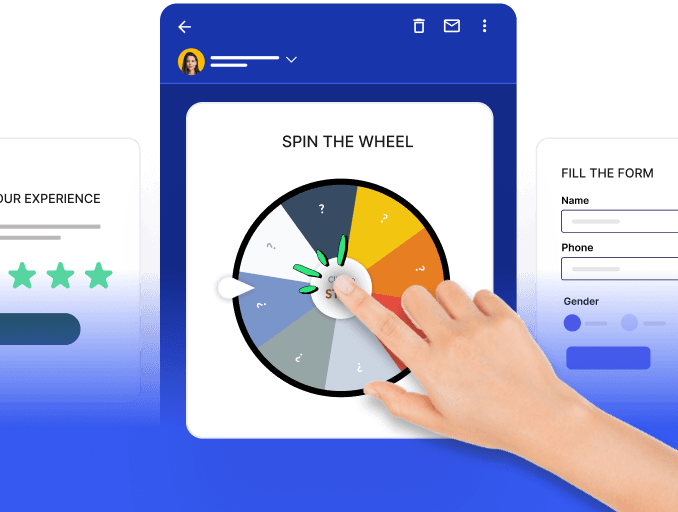Newsletters are one of the most effective ways for businesses to keep their customers engaged. Brands and businesses regularly use newsletters to propagate regular updates about their company to their customers about upcoming products, events, their company goals and so on. However, creating and sending newsletters regularly can be a daunting task. This is where automated newsletters come in.
In this guide, we will explore the advantages of using newsletter automation, popular platforms for creating them, and how automation can be utilized in different aspects of creating and sending newsletters.
What are automated newsletters?
Automated newsletters are pre-scheduled email updates that are sent to subscribers without manual intervention. They're often tailored to each recipient based on their interests and behavior, delivering relevant content and keeping the audience engaged.
These automated emails save time and ensure consistent communication, making them a valuable tool for businesses and organizations looking to maintain a strong online presence and nurture customer relationships.
Advantages of using automated newsletters
Automating newsletters offers a lot of advantages. Some of them are as follows:
1. Time-efficiency
Automating newsletters saves time and reduces the manual effort required to send out regular updates. You can schedule newsletters in advance, and the system will send them automatically, allowing your team to focus on other tasks.
2. Consistency
By automating newsletters, you can send them out consistently every day, every week, or every month. Your audience will be more engaged and trusting if you do this.
3. Cost saving
Automating newsletters can help to save costs in terms of manpower and resources as manual processes are eliminated. Additionally, automated newsletters can be sent out to a large number of people without incurring extra costs.
4. Scalability
Automated newsletters make it easier to scale up the number of people you are sending newsletters to, as the process is automated and all you need to do is pre-schedule the newsletters and the system will take care of the rest. This makes it easier to reach a larger audience and grow your newsletter list with minimal effort.
5. Reduction in human error
Automating newsletters helps to reduce the risk of human error, as the entire process is automated and all the newsletters are sent out as per the pre-scheduled time. This ensures that the newsletters are sent out error-free and on time.
💡 Related guide: 7 Best Newsletter Automation Strategies for Modern Marketers
5 types of newsletters to send
Businesses have the flexibility to set up various types of automated newsletters to align with their unique goals and objectives. Let's explore some common examples:
1. Newsletters by Verticals: Crafting newsletters tailored to specific verticals is an effective content strategy. If your content spans across multiple categories, consider creating specialized newsletters for each vertical. You can use your Content Management System (CMS) categories or tags to automate the selection of content, ensuring that subscribers receive content that precisely matches their interests.
2. Daily Newsletters: These serve as the cornerstone of an email newsletter program, offering a convenient way for your audience to access your content on a daily basis. You can automate this process by leveraging RSS feeds or using an Email Service Provider (ESP) that seamlessly integrates with your Content Management System (CMS). This automation ensures that your daily newsletters are consistently filled with fresh content, saving you time on crafting exclusive newsletter materials.
3. Top Performing Content Newsletter: Design a newsletter explicitly dedicated to showcasing your top-performing content. By sending out only the most engaging articles, you provide a newsletter that maximizes user engagement without overwhelming them.
4. Weekly Round-up Newsletter: Some subscribers may prefer a weekly email update. Make the most of this weekly engagement by curating content that encourages user interaction. Prioritize content within your CMS or apply additional tagging to guarantee that your weekly round-up newsletter delivers the most significant updates from the week, keeping your subscribers well-informed.
5. Educational Newsletter: Tailor newsletters to educate your audience on specific topics or industry trends. Share valuable insights, tips, and educational content to position your brand as an authority in your field and nurture lasting relationships with your subscribers.
Each of these automated newsletter types serves a unique purpose in engaging your audience and achieving your marketing objectives.
How to set up an automated newsletter
Setting up an automated newsletter involves several steps. Here's a step-by-step guide to help you get started:
Step 1: Define the goals you want to achieve with your newsletter automation. Whether it's increasing sales, driving website traffic, or improving customer engagement, clearly define your goals before proceeding.
Step 2: Choose an automation tool that suits your needs and budget. Consider factors such as ease of use, integration capabilities, and customer support when making your decision.
Step 3: Segment your audience based on relevant criteria such as demographics, purchase behavior, or engagement level. This will allow you to deliver personalized content to different groups of subscribers.
Step 4: Design your newsletter template that aligns with your brand identity. Ensure that the template is visually appealing, mobile-responsive, and easy to read. You can also pick an editable email template from a template library like Mailmodo’s.
Step 4: Create compelling and relevant content that resonates with your audience. Consider using a mix of educational, entertaining, and promotional content to keep subscribers engaged.
Step 5: Collect email subscribers for your email list. Automation tools can automate the process of collecting email subscribers by integrating with signup forms on websites or social media platforms. This ensures that new subscribers are added to the mailing list without manual effort.
Step 6: Set up automation triggers or actions that will initiate the sending of your newsletter. For example, you can set up triggers based on time intervals, subscriber behavior, or specific events.
Step 7: Test and optimize before launching your newsletter automation to ensure everything works as intended. Test different elements such as subject lines, CTAs, and email design to optimize for better results.
Step 8: Launch and monitor your automated newsletter once you are satisfied with the setup and testing. Pay attention to metrics such as open rates, click-through rates, and conversions to gauge the effectiveness of your campaign.
Popular platforms for setting up automated newsletters
There are several popular platforms available for creating newsletter automation. Here are a few notable options:
Mailmodo: Mailmodo is a comprehensive email marketing platform known for its expertise in crafting interactive and personalized newsletters. This versatile platform provides a wide array of templates, robust automation features, and in-depth analytics. Its features include a visual customer journey builder, an analytics dashboard, A/B testing, an AI email subject line generator and send time optimization.
Mailchimp: Mailchimp is a widely used email marketing platform that offers robust automation features. It provides a user-friendly interface, customizable templates, and detailed analytics to track the performance of your newsletters.
ActiveCampaign: ActiveCampaign is known for its advanced automation capabilities. It allows businesses to create complex automation workflows based on various triggers and conditions. The platform also offers CRM features to manage customer relationships.
Takeaways
Newsletter automation offers numerous advantages for businesses, including time efficiency, personalized customer experiences, and improved customer retention rates. By leveraging automation tools and following a step-by-step process, businesses can set up effective newsletter automation that delivers the right content to the right audience at the right time.
Whether you're looking to enhance the visual appeal of your emails, streamline your campaigns, or gain valuable insights into their performance, Mailmodo has you covered. Its user-friendly interface and feature-rich toolkit make it a go-to choice for businesses aiming to optimize their email marketing efforts.







